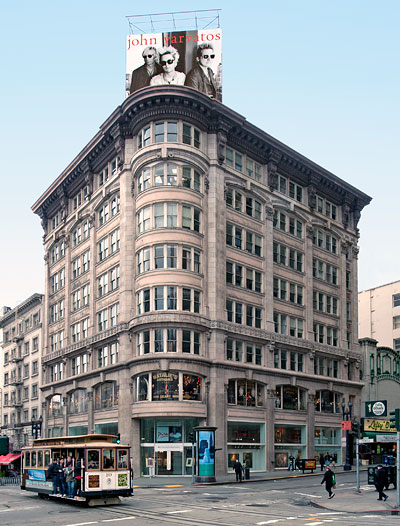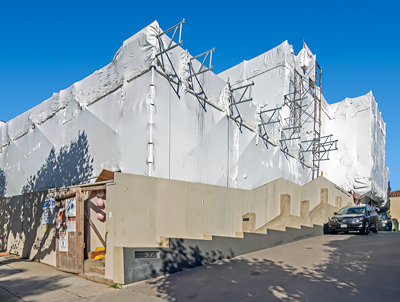Gustave Albert Lansburgh (1876-1969)
G. Albert Lansburgh is known for his opulent movie palaces built between 1910 and 1930.
Lansburgh was born in Panama but moved to San Francisco with his family. While a student at UC Berkeley, he worked for Bernard Maybeck as a draftsman. After graduating from Berkeley, he earned a degree from the École des Beaux-Arts in 1906.
Lansburgh returned to the Bay Area in May, 1906, one month after the Earthquake and Fire. He designed numerous buildings in the recovering city. Among these was his first theater, the Orpheum Theatre on O'Farrell Street which opened in 1909. (The Orpheum Theatre was renamed the Columbia Theatre in 1927 when a new Orpheum Theatre (San Francisco Landmark #94) designed by Benjamin Marcus Priteca opened on Market Street. Lansburgh's Columbia Theatre was demolished in 1938.)
Lansburgh went on to design more than fifty theaters nationwide. At the height of his career, he had offices in San Francisco, New York, and Los Angeles.
Although most of Lansburgh's best known buildings are in the West, his personal favorite was said to have been the Al Hirschfeld Theatre (originally the Martin Beck Theatre) in New York City.
| Name | Year | Address | City | Sort Address | Sort Name |
|---|---|---|---|---|---|
| Carnegie Library: Sunset | 1918 | 1305 18th Avenue | San Francisco | Avenue 18 1305 | Carnegie Library: Sunset |
| Hotel Senator | 1924 | 1121 L Street | Sacramento | Street 11 | Hotel Senator |
| Orpheum Theatre | 1913 | 46 West 200 South | Salt Lake City | Street W 200 | Orpheum Theatre |
| Carnegie Library: Mission District | 1916 | 300 Bartlett Street | San Francisco | Bartlett 0300 | Carnegie Library: Mission District |
| Lowenstein House | 1914 | 2201 Broadway | San Francisco | Broadway 2201 | Lowenstein House |
| Gunst Building | 1908 | 301 Geary Street | San Francisco | Geary 0301 | Gunst Building |
| Temple Emanu-El | 1926 | 2 Lake Street | San Francisco | Lake 0002 | Temple Emanu-El |
| Emporium Department Store | 1908 | 865 Market Street | San Francisco | Market 0835 | Emporium Department Store |
| Warfield Theatre | 1922 | 982 Market Street | San Francisco | Market 0982 | Warfield Theatre |
| Miramar Apartments | 1917 | 1580-1598 Market Street | San Francisco | Market 1580 | Miramar Apartments |
| El Capitan Theatre | 1928 | 2353 Mission Street | San Francisco | Mission 2535 | El Capitan Theatre |
| Residence | 1924 | 3052 Pacific Avenue | San Francisco | Pacific 3052 | Residence |
| Carnegie Library: Chinatown | 1921 | 1135 Powell Street | San Francisco | Powell 1135 | Carnegie Library: Chinatown |
| Carnegie Library: Presidio | 1921 | 3150 Sacramento Street | San Francisco | Sacramento 3150 | Carnegie Library: Presidio |
| Hammersmith Building | 1907 | 301-303 Sutter Street | San Francisco | Sutter 0301 | Hammersmith Building |
| Golden Gate Theatre | 1922 | 1 Taylor Street | San Francisco | Taylor 0001 | Golden Gate Theatre |
| War Memorial Complex | 1932 | 301 Van Ness and 401 Van Ness | San Francisco | Van Ness 0301 | War Memorial Complex |
Photographed 17 October 2019
Before the 1906 Earthquake and Fire, rich and powerful San Franciscans built their homes on Rincon Hill and then on Nob Hill. Since then, they have preferred Pacific Heights and Presidio Heights.
In San Francisco fortunes were made in gold, silver, banking, railroads, shipping, sugar, pineapples, coffee - and now, technology.
In March 2019, Forbes published an article titled "Richest Cities In The World: The Top 10 Cities With The Most Billionaires." Two United Sates cities were on the list. New York City with eighty-four billionaires was first. The city of San Francisco, with forty-two billionaires, was seventh. (The San Francisco Bay Area had eighty-two billionaires just trailing New York City.)
Much of this money is still pouring into Pacific Heights. It seems that almost every block has at least one gutted mansion being remodeled.

